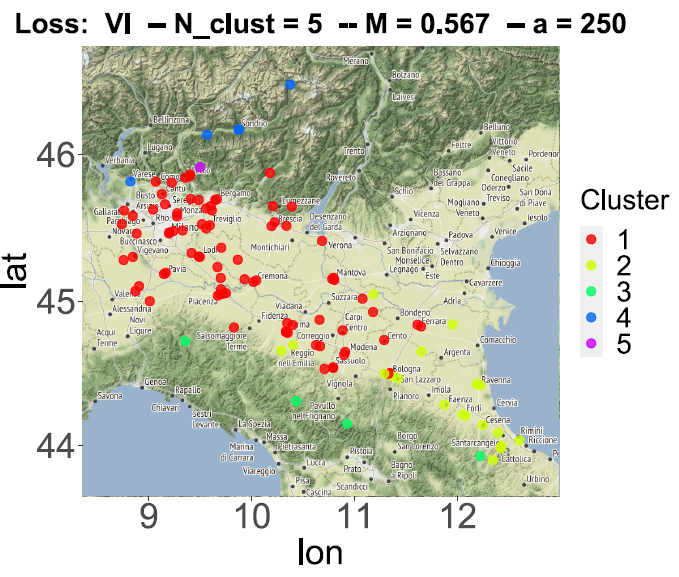Clustering spatial time series via Bayesian nonparametrics
Abstract:
This project employs Bayesian nonparametric methods to cluster spatial time series data, focusing on PM10 air pollution measurements across Northern Italy. By integrating the Bayesian approach with nonparametric mixture models, we tackle the challenge of unknown cluster numbers, enhancing the understanding of air pollution dynamics. The analysis is underpinned by the extension of the C++ library Bayesmix, facilitating a novel methodological framework for environmental data analysis.
Introduction:
Northern Italy’s air quality, influenced by industrial, traffic, and geographical factors, presents a complex spatial and temporal pollution pattern. This study analyzes PM10 concentrations recorded in 2018, aiming to uncover hidden structures and correlations within the data. Through Bayesian clustering, we seek to identify areas with similar pollution behaviors, offering insights into the underlying causes of air pollution.
Methodology:
The core of our methodological approach involves a Bayesian Spatial Product Partition Model, leveraging the Dirichlet Process for flexible clustering. This model accounts for spatial dependencies, allowing us to classify sensing stations into clusters with statistically similar pollution levels. Key to our analysis is the innovative use of the ARMA model for time series data, ensuring accurate representation of temporal dynamics.
Results:
Our findings reveal distinct spatial clusters that correspond to varying levels of industrial activity, traffic density, and geographical features. The Bayesian framework efficiently segregates areas of high industrial pollution from those affected by urban and traffic-related pollution. Notably, the model identifies unique clusters in densely populated areas of the Po Valley, reflecting the significant impact of human activity on air quality.

Conclusion:
This study demonstrates the potential of Bayesian nonparametrics in environmental science, particularly for analyzing complex spatial time series data. Our clustering approach not only elucidates the spatial distribution of air pollution in Northern Italy but also sets a precedent for future research on environmental monitoring and policy-making.
Further Work:
Exploring the integration of additional environmental and socio-economic variables could further refine our understanding of pollution patterns. Expanding the Bayesian clustering framework to include predictive modeling would also enhance its applicability to proactive environmental management strategies.
For more details on our methodology, results, and the implications of our study, please refer to our comprehensive report.
